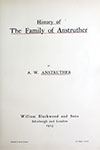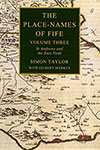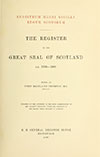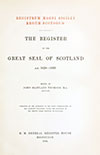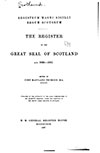

James Gordon, 1642image courtesy of NLS
Thirdpart is the site of a castle of which nothing now remains on site.
Originally Thirdpart was a part of the lands of Capelochy or Caiplie, which are first mentioned in 1235. In that year Richard de Beaumont gave all the land of Caplawin and three oxgangs of land in the neighbouring field of Ratheruch to David, son of Hugh White of Haddington, for his homage and service, with an annual rent of twelve pence to be paid at Crail. Richard is thought to have been the nephew or great-nephew of Ermengarde of Beaumont, the wife of William the Lion.
Another David was described as “domino de Caplawhy” in 1312 and a Margaret of Caplachy, daughter of John of Caplachy, is on record in 1381.
During the reign of Robert III, in the late 14th or early 15th century, the laird of Thirdpart is said to have been involved in a conflict with Sir William Anstruther of Anstruther, although another version of the story states that Anstruther’s dispute was with Sir Neil Cunningham of Barns.
Sir William Anstruther and his daughter, Margaret, resided at Dreel Castle in Anstruther at the time, his son being at the court of Robert. Margaret is said to have fallen in love with the 22 year old Patrick Home, son of Earl of Home, whose ancestor had supposedly killed Sir William’s grandfather on the Firth of Forth. However the laird of Thirdpart seems to have had intentions regarding Margaret of which Sir William did not approve leading him to insult the laird. This prompted the laird to devise a plot to kill his neighbour.
The laird invited Sir William and Margaret to Thirdpart but a wandering beggar got wind of the plan and informed Sir William who then invited the laird to Dreel instead. When he arrived Sir William hit him over the head with an axe and killed him. Sir William vowed to repay the beggar’s kindness in warning him of the danger and did so by offering his daughter’s hand in marriage, at which point the beggar is supposed to have cast off his disguise to reveal himself to be Patrick Home.
By the late 15th century the lands of Caiplie had been split into two unequal parts, the upper or over and the lower or nether. The upper third became known as Over Caiplie, Thirdpart of Caiplie or simply Thirdpart, while the lower two thirds remained known as Caiplie, Capelochy or Netherton of Caiplie.
Both parts of Caiplie were owned by Alexander Inglis of Tarwald, who in March 1488 resigned his lands of Tarwald and Caploquhy, superior and inferior, with their mills, and the half lands of Balbirny, which were then incorporated for him into the free barony of Tarwald.
Alexander Inglis, who was dead by 1518, was succeeded by his son, also Alexander, who was married to Margaret Barclay, a daughter of Barclay of Innergellie. The younger Alexander resigned his lands of Tervait, including Thirdpart, in February 1541 and they were then erected into the free barony of Tarvait by James V for Alexander’s good service.
Alexander died at the Battle of Pinkie in 1547 and in 1548 his heir, also Alexander, was granted the barony and lands of Tarvet, the lands of Caiplie, Ovirtoun, Thrid part, the lands of Nethertoun de Caiplie with the mill, the half lands of Balbirny and fisheries, the dominical lands of Tarvett with Outsattis annexed to the barony of Tarvett, and the lands of Eister Pitcorthie.
The younger Alexander later resigned the lands and barony of Tarvat, including Thirdpart, and in December 1579 James VI granted them to John Inglis, Alexander’s son and heir apparent. John was married to Elizabeth Carnegie, daughter of David Carnegie of Colluthie.
Alexander died around 1590 and in 1604 John sold to his son, another Alexander, the lands and barony of Tarvet which included Thirdpart. John was dead by 1610 and in October 1611 Alexander subsequently sold the lands of Caple-Ovirtoun Thridpairt, Nethertoun de Caple, with the mill, mill lands, etc., fisheries, fortalice and manor, and the lands of Eister Pitcorthie, with the consent of his wife, Martha Johnstoun, daughter of James Johnstoun of Elphingstoun, and his mother, Elizabeth Carnegie, to John Scot of Knychtspottie.
These lands were incorporated into the free barony of Caple, with Thridpairt as its principal messuage, for John Scot who was afterwards known as Sir John Scot of Caiplie, the Director of Chancery. The following month James VI confirmed a charter by Alexander Inglis to Sir John of the lands of Tarvett. Sir John would later be known as Sir John Scot of Scotstarvit.
In February 1619 the James VI granted to John Scott of Scottistarvet the “decimas garbales et vicarias decimas” lands of Over Caplie alias Thridpairt, the town and lands of Nethir Caplie with the mill and mill lands, and the town and lands of Eister Pitcorthie, which the Earl of Mar had resigned with the consent of William Barclay de Innergillie.
In the 1620s the poet William Drummond of Hawthornden wrote a humorous poem entitled Polemo-Middinia about a dispute over access rights between the Scotts of Thirdpart and their neighbours the Cunninghams of Barns. In the poem the Lady Anne Scott and Lady Cunningham egg on their servants and retainers in a fight between the two parties. Drummond was engaged to Cunningham’s daughter and his sister, Anne, was married to Sir John Scott.
In July 1635 Charles I made a new grant to James Scot, son of Lord John Scot of Scottistarvett, and Margaret or Marjorie Carnegie, his spouse, and their male heirs, of the lands and barony of Tarvett which included the lands of the lands of Caiplie-Ovirtoun known as Thridpairt with the pendicle of Scabert.
Their eldest son, also James, died unmarried and Thirdpart and the barony of Tarvet passed to his brother, David Scot, who married firstly Nicola Grierson, daughter of Sir John Grierson of Lag and secondly Elizabeth Ellis, daughter of John Ellis of Elliston (John Ellis was married to David’s aunt, Rebecca Scot).
The estates next passed to David Scott of Scotstarvit and Balcomie, eldest son of David and Elizabeth, however he died without issue by 1785 and was succeeded by his brother, General John Scott. The General had three daughters with Margaret Dundas, daughter of Robert Dundas of Arniston, and upon his death in 1775 his Fife estates passed to the eldest, Henrietta.
Soon after her father’s death Henrietta sold Thirdpart and Netherton of Caiplie to Sir Alexander Anstruther, grandson of Sir Robert Anstruther of Balcaskie. The estates then passed to his son, Robert Anstruther of Caiplie.
Robert died in 1855 or 1856 and was succeeded by his brother, Major-General Philip Anstruther of Caiplie. The Major-General was succeeded by his eldest son, Philip George Anstruther, who in 1919 sold Thirdpart to the Board of Agriculture for Scotland and smallholdings for ex-servicemen were set up on the land.
In 1987 two architectural fragments of stone were found during archaeological field work at Thirdpart. One stone was the apex of a pediment decorated with chevrons in relief with opposing edge-scrolls while the other was from the left side of a carved heraldic panel and included the letter H, part of a coat of arms, a rosette and part of a scroll. Both had formerly been built into the steading at Thirdpart Farm (NO 589 067), now demolished, and are now located in Crail Museum (accession numbers 1987: 41 and 1987: 42).
Alternative names for Thirdpart
Caiplie Overton; Caiplie Ovirtoun; Capell-Overtoun; Caple-Overtoun; Caple-Ovirtoun; Caple-Ovirtoun Thridpairt; Caplie-Overtoun; Old Kiplaw; Over Caiplie; Over Capley; Overton; Overton of Caiplie; Ovir-Capley; Ovirtoun; Ovirtoun de Caplie; Third Part; Third-Part House; Thrid pairt; Thrid part; Thrid-Part; Thridp; Thridpairt; Upper Caiplie








